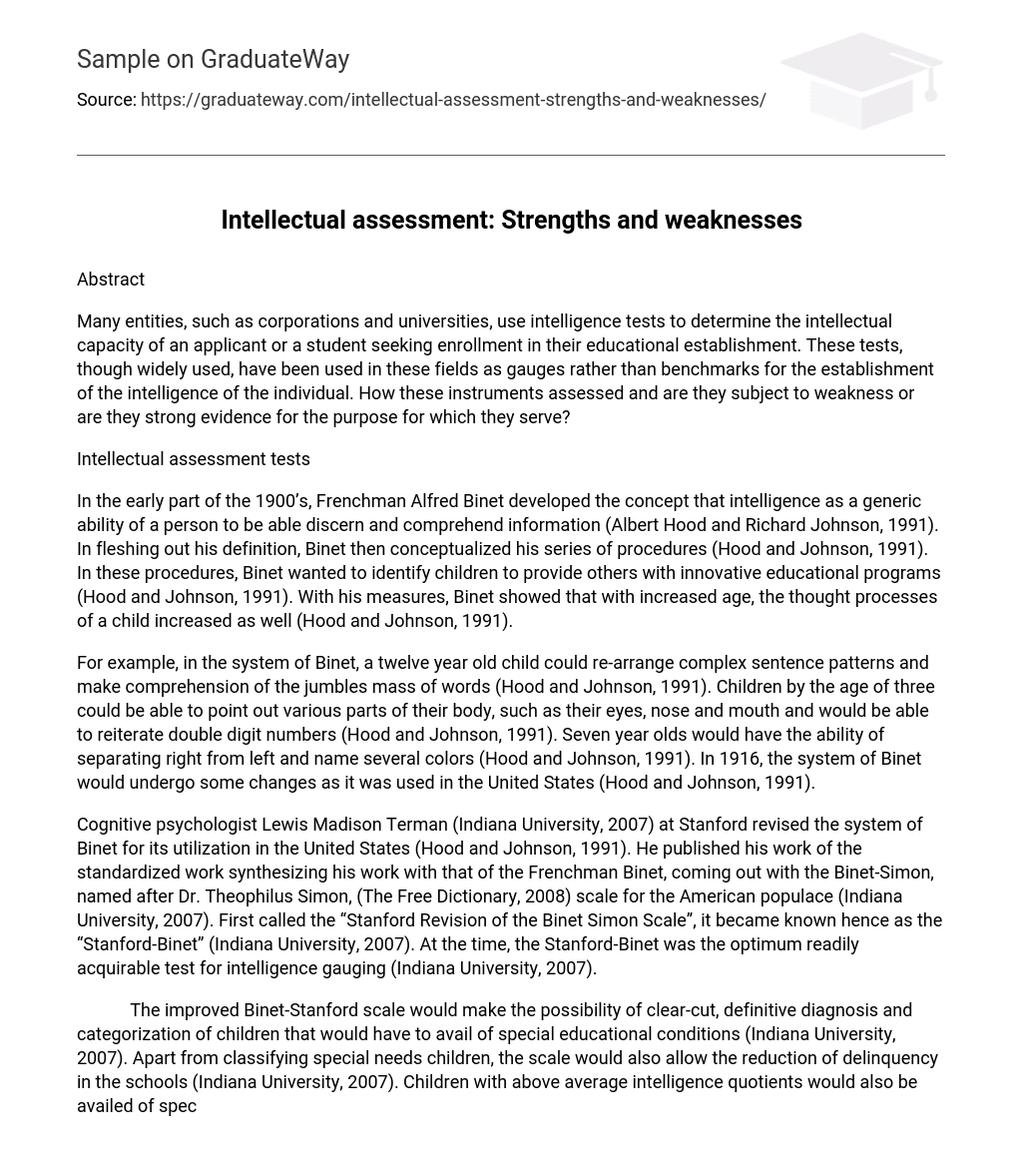Abstract
Many entities, such as corporations and universities, use intelligence tests to determine the intellectual capacity of an applicant or a student seeking enrollment in their educational establishment. These tests, though widely used, have been used in these fields as gauges rather than benchmarks for the establishment of the intelligence of the individual. How these instruments assessed and are they subject to weakness or are they strong evidence for the purpose for which they serve?
Intellectual assessment tests
In the early part of the 1900’s, Frenchman Alfred Binet developed the concept that intelligence as a generic ability of a person to be able discern and comprehend information (Albert Hood and Richard Johnson, 1991). In fleshing out his definition, Binet then conceptualized his series of procedures (Hood and Johnson, 1991). In these procedures, Binet wanted to identify children to provide others with innovative educational programs (Hood and Johnson, 1991). With his measures, Binet showed that with increased age, the thought processes of a child increased as well (Hood and Johnson, 1991).
For example, in the system of Binet, a twelve year old child could re-arrange complex sentence patterns and make comprehension of the jumbles mass of words (Hood and Johnson, 1991). Children by the age of three could be able to point out various parts of their body, such as their eyes, nose and mouth and would be able to reiterate double digit numbers (Hood and Johnson, 1991). Seven year olds would have the ability of separating right from left and name several colors (Hood and Johnson, 1991). In 1916, the system of Binet would undergo some changes as it was used in the United States (Hood and Johnson, 1991).
Cognitive psychologist Lewis Madison Terman (Indiana University, 2007) at Stanford revised the system of Binet for its utilization in the United States (Hood and Johnson, 1991). He published his work of the standardized work synthesizing his work with that of the Frenchman Binet, coming out with the Binet-Simon, named after Dr. Theophilus Simon, (The Free Dictionary, 2008) scale for the American populace (Indiana University, 2007). First called the “Stanford Revision of the Binet Simon Scale”, it became known hence as the “Stanford-Binet” (Indiana University, 2007). At the time, the Stanford-Binet was the optimum readily acquirable test for intelligence gauging (Indiana University, 2007).
The improved Binet-Stanford scale would make the possibility of clear-cut, definitive diagnosis and categorization of children that would have to avail of special educational conditions (Indiana University, 2007). Apart from classifying special needs children, the scale would also allow the reduction of delinquency in the schools (Indiana University, 2007). Children with above average intelligence quotients would also be availed of special classes in correlation to their intelligence ratings (Indiana University, 2007). The scale would also prove to be a valuable instrument for research purposes (Indiana University, 2007).
Along with the Weschler intelligence scales, the Stanford- Binet scales can be defined as possessing the qualities of a good test, in that the results they provide are fairly reliable and valid (Eugene McKenna, 2000). But the scope of the Stanford Binet scales was merely confined to the deduction of intelligence of children (Hood and Johnson, 1991). David Weschler, then employed at the Bellevue Hospital in New York, was of the belief that there should be a scale for the determination of intelligence in adults (Hood and Johnson, 1991). Hence, the work he crafted became known as the Weschler Bellevue Intelligence scales, released in 1939 (Hood and Johnson, 1991).
Even though the use of the Stanford-Binet test can be allowed on children as old as two, users of the tests should exercise caution in the administration of the tests (The Free Dictionary, 2008). The test cannot be utilized in the detection of delays in the development of children (The Free Dictionary, 2008). Also, the test is inutile in diagnosing the instance of mental disabilities of children three years old or younger (The Free Dictionary, 2008).
References
Hood, A. B., Johnson, R.W. (1991). Assessment in Counseling: A guide to the use of psychological Assessment procedures. Virginia: American Association for Counseling and Development.
Indiana University. (2007). Lewis Madison Terman. Retrieved January 12, 2009, from
http://www.indiana.edu/~intell/terman.shtml
McKenna, E. (2000). Business Psychology and Organisational Behavior. United Kingdom: Psychology Press.
The Free Dictionary. (2008). Stanford-Binet intelligence scales. Retrieved January 12, 2009, from http://medical-dictionary.thefreedictionary.com/Stanford-Binet+Intelligence+Scales





